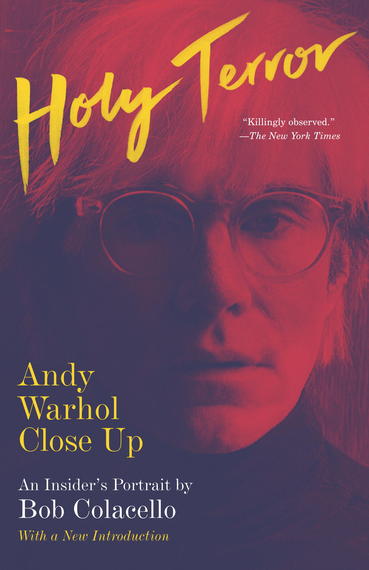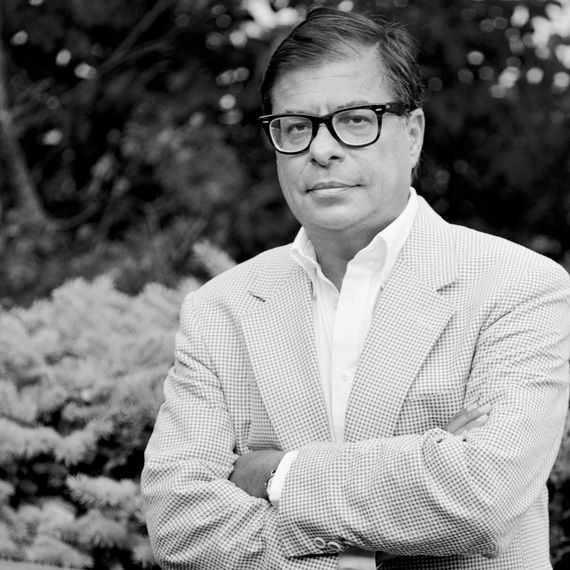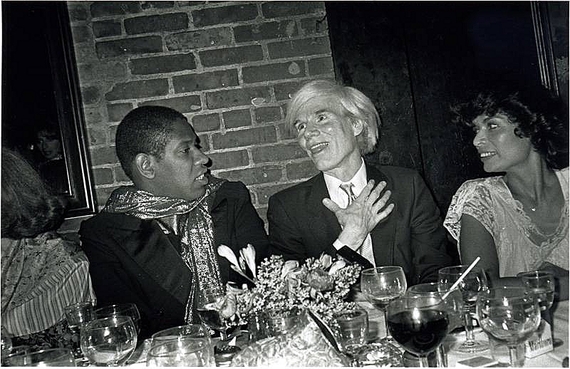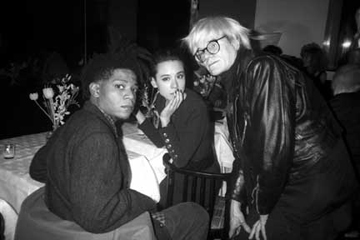The press release that recently came across my desk for the re-issue of my friend Bob Colacello's iconic, must-read memoir of his time alongside Andy Warhol tees it up perfectly:
After Valerie Solanas's 1968 attempted murder of Andy Warhol, the artist retreated from public accessibility and became more entrepreneurial, spending his time in the company of a veritable Who's Who of 1970s rich and famous. By his side was Bob Colacello, editor of Warhol's Interview magazine and--for more than a decade--his collaborator, wingman, and confidante.
Bob's HOLY TERROR: Andy Warhol Close Up is a rare and definitive portrait of the ever-enigmatic cultural titan, originally published in 1990...
From the Silver Factory to the Interview offices; from Studio 54 to a compound in Montauk, Bob went where Andy went--and knew him as both the domineering, influential artist who loomed large on the world stage and the shy, vulnerable man who came from Pittsburgh's Slavic ghetto. Warhol just as easily bedeviled as bedazzled; he knew how to push his collaborators' buttons and play both sides of conflict within his coterie...In HOLY TERROR, Bob pulls back the institutional red ropes to offer a between-the-scenes memoir that, most of all, makes a case for Warhol being human.
Holy Terror is my favorite book about Andy Warhol. Bob Colacello is one of my favorite writers -- and people -- so of course, I had to call him to discuss this exciting news, which somehow he had neglected to tell me about...(ahem).
CJ: Mr. Cola! (note: read the book and you will understand the Cola thing) First off, where are you and what are you doing?
BC: I'm in East Hampton and I'm sitting in my backyard taking in a little sun on an early spring day.
CJ: Oh that sounds just awful.
BC: Ha!
CJ: So we're here on the phone to talk about the recent re-release of your masterpiece memoir of life with Andy Warhol. I didn't draw up any questions in advance because you and I are friends in real life, and I just wanted to have a casual conversation about it with the hope that it makes for more interesting reading. I first read the original hardback Holy Terror long before I met you and to this day, I maintain that it is the best book ever written about Andy Warhol and the Factory days. It's perfection. So why an updated version with the new intro and so forth?
BC: Well, it wasn't really a decision on my part although you always hope as an author that a book that goes out of print somehow winds up back in print. These days publishers like to put out-of-print books into e-book form, but I really wanted to do an update. And out of the blue, I got a call from an editor friend at Knopf and she said that they were interested in putting out an update for their vintage paperback line. So I was more than thrilled and it was suggested that perhaps I could do a 1,000 word new introduction covering what's happened with the whole Warhol thing since 1990 when the first edition hardcover came out and, uh, that was about August 1st and I sat down at my computer here in East Hampton and on on August 30th I'd written almost 10,000 words!
CJ: How could you not?
BC: Exactly. I was like, sorry this has gotten so long, but so much has happened! And the Editor said well let's just call the chapter "So Much Has Happened 1990-2014."
CJ: I think that's perfect and frankly I'm surprised you got it all down to 10,000 words! What would Andy think about the "So Much That Has Happened?"
BC: He'd be thrilled! I mean, wherever he is (laughs)...you know, I don't think he'd be that amazed because he was so driven to be the Picasso of the second half of the 20th century. He was, as Billy Name said in the acclaimed Ric Burns documentary about Andy, uninterested in being a second-tier artist. He was uninterested in being a first-tier artist! He wanted to be, you know, a god. Someone who completely changed the...he wanted to be Zeus with the lightning bolt and nothing less would have satisfied him. Andy put on his fey kind of act, but he wanted to be number one and he succeeded. But you never know. Fifty years from now he might not be seen as so important, but the way our whole culture has gone, and the way it continues to go, is his way--for better or for worse.
CJ: Absolutely. I know you are a very busy guy and you have a lot going on, which we'll get into later, but I am so appreciative that you took the time to update Holy Terror and to give your take on what's happened since 1990. So we know it was hard for you in terms of word count, but was it hard for you emotionally? To dive back in and all?
BC: I could write an entirely new book about Andy, but I don't think I will. I certainly don't think Nancy Reagan would like that, as she's been patiently waiting for Volume 2 of my chronicle of the life of her and Ronnie. Fortunately I had a great intern who did a lot of the research on Andy's prices, which of course are phenomenal, but getting them straight--you know, he's reached this $100million plateau that only a handful of other artists have reached, which puts him in the company of Cezanne, Klimt, Picasso, and such. It's been so long now and so much has happened that I am able now to look back with much less emotion and my take on Andy as an artist now comes down to a simple sentence: he made religious art for a secular society which is why it has so much appeal. I think his portraits of Jackie, Liz, Marilyn, Mao, Elvis, Lenin--and objects like the soup cans, the dollar signs, the hammer and sickle, it's all about icons. Its all about what people worship in an irreligious or secular world. In terms of Andy's personality and Andy as a human being who I was very close to, I still feel kind of sorry for him on a personal level. I mean, he was the ultimate example of great success wrapped around inner turmoil and emotional pain.
CJ: I like in your updated intro where you say that "reality TV, Facebook, Instagram, Twitter, WikiLeaks, Weiner sexting scandal.....all pure Warhol. A society in which narcissism, exhibitionism and voyeurism run rampant, celebrity and notoriety have merged, and fame is the ultimate goal." Andy would feel right at home, you say.
BC: (Laughs) Yeah. That does sum it up if I say so myself! Very few people actually saw Andy's films like Chelsea Girls where he filmed seven hours, ran it on two screens, where each scene was in a different room at the Chelsea Hotel with these people he called 'Superstars" who were basically super-exhibitionists--the guy in one room high on LSD talking about masturbation, Brigid Berlin in another room playing a lesbian and shooting up people with amphetamines right through their jeans, it was all real and they were really doing it (though Brigid is now a proper lady), but you know Andy really did pre-date reality TV. His films were way ahead of the times...and I'm not suggesting this has all necessarily been a good thing for America, mind you. I kind of think we're all in a really big mess, kind of like the end days of the Roman Empire.
CJ: Well things have gone the way he predicted they would. And on that note, your new Epilogue in the reissue is called "Andy Is Everywhere" and I like that because I've been a Warhol fan since I was a teenager. As you know, I called him up one day out of the blue and he did his whole "Oh, Gee" "Wow" "Come see Us" thing with me....
BC: You called the Factory?
CJ: Yeah! I told you this story! You don't remember?
BC: I think I do, but I never recorded it. Remind me.
CJ: OK. I was like sixteen years old. Living in Southern California, where I grew up. I LOVED Nick Rhodes and Duran Duran and two of Nick's favorite people were Andy and Patrick Nagel...so one day from my Mom's house, I called information, got the number for the Factory and called. And I was like, "Hi, I'm a teenager calling from California and I'd really like to talk to Andy...." And the guy was like, "OK hold on..." and in your update you quote Paul Morrissey saying that Andy's vocabulary consisted entirely of "Oh really," "Wow," and "Gee" - that was totally how it went. He invited me to come to the Factory and hang out. I was skeptical as to whether it was Andy on the line or not, but it was awfully funny. And fun. He died before I could get there, unfortunately. But I had every intention of going! When I heard that the Diaries were being published, I hoped that maybe I had warranted a mention, but alas...
BC: Oh, I think it was him absolutely! One thing about Andy that was remarkable and also key to his widespread appeal is that he was so open! He would get on the phone and talk to the kid who called to say he was a fan--you know, Andy would walk from his house every morning down to the Factory carrying a bunch of Interviews--people would stop him and he would sign them, and what have you. He engaged people and I think all of that is what helped keep him keyed in to the times beyond all of the celebrity stuff that was going on around him. He was much more like a fan than a celebrity himself. A lot of people found themselves working at the Factory and some even in his bed as a result of random occurrences like your call. Most famous artists have never been all that interested in meeting strangers. That was not the case with Andy at all.
CJ: Let's switch gears a bit. Some folks have suggested over the years that Andy really didn't do much--that he relied on these young people to kind of do the work for him. But you suggest that no one worked harder than Andy. Talk about that...
BC: He went out every evening to five or six parties with a tape recorder in one pocket and a camera with extra film and batteries in the other pocket, constantly recording and photographing everyone he came across. Mind you this was after he had woken up at nine AM to make several phone calls, including to Pat Hackett to dictate his diary and to me to see what was going on with Interview--he'd be on the phone from 9 until about 11:30 directing all of us, and then he'd make his way to the Factory where there was always a business lunch and someone to impress or sell something to (the 'victims' we'd call them), which we made extra fun by inviting diplomats, models, athletes, what have you. But it was work. And then he'd announce halfway through lunch that he had to go to work and he'd paint from maybe 2 PM to 7PM, rush home, and eat some turkey or roast veal with potatoes or white rice--always very plain with no salt, gravy, whatever because he had his gallbladder problem---and then go off to another night on the town, taking pictures and tape recording everything along the way.
CJ: Let's talk about Andy and Jean-Michel Basquiat. The connection between those two seemed to be awfully deep.
BC: I think Andy was really in love with Basquiat. And Basquiat died not long after Andy. I think he just gave up completely when Andy went. Andy was trying very hard to keep Basquiat off of heroin. It's so sad because even as crazy as that all seems you think that maybe that could have been a way that Andy could have found some happiness...but you know, he died, Basquiat died...
CJ: As I said before, Holy Terror is my favorite book about the world of Warhol...in fact it's one of my favorite books of all time. The original hardcover version came out not much after Andy's death. It was and remains a sometimes brutally honest reflection on Andy and your time with him. I mean, it's definitely not a love letter. How was it received in 1990 when it first came out?
BC: Well his Diaries came out before my book--he was dead when they were published, but Fred Hughes authorized them and Pat Hackett edited them--and they were pretty brutal to me! (laughs) Not that they weren't--I mean, I really did vomit in Halston's sink one night...was drinking too much....cocaine....you know, as honest as I was about other people, I was honest about myself because otherwise the reader wouldn't believe it. Fran Lebowitz said she thought I was really honest but I wasn't really mean to anyone. You know, the Warhol world was not a world where people held back. But yeah, when I wrote it I was in a very emotional state. I was very pissed at Andy and Fred Hughes when I left there because they had been so dishonest with me on some business matters and the fact of the matter is that Fred was great, Fred was a mentor to me over the years, but his drinking and cocaine use was so out of control. He sabotaged so many portrait commissions that I was about to get for Andy--he just was a disaster. Anyway, when I finished the book, I handed it in, didn't want to read it again, but when it finally was in print I felt like OK, I have to read this. And yeah, I thought God, this is petty, this is silly, too emotional, too raw...and maybe it was then, but now it all seems that it's so much better because all the stuff that felt petty and silly now seems more relevant because Andy was so important.
CJ: Well all of that rawness and emotion is one of the reasons why Holy Terror is excellent, and why everyone should go out and get the re-issue. I mean, Andy IS everywhere now and that honest look is of immense historic value. But here's something I've wondered about you - you do a lot. Vanity Fair. The Reagan books. And so on. Do you get tired of being hit up all the time about Andy?
BC: Well, I mean when the book first came out it was not a bestseller, but it got good reviews and at that point I was done writing about Andy, done talking about Andy....but now, I kind of love it (laughs). All these smart, attractive young people think I'm cool! So here I am a guy in his sixties with all of these interesting friends in their twenties. It's very stimulating and keeps me very much in the present.
CJ: I can vouch for that! My twenty year old daughter thinks you are Le Shit!
BC: See? (laughs) I do feel very blessed that something I did twenty five years ago now has a new life. You know, I was just in Washington giving a talk at the Aspen Institute where I was introduced and interviewed by Paul Richard, the long time art critic at the Washington Post, who started off by saying that Holy Terror was the best portrait in prose of an American artist he had ever read. And he's read them all! So I've been bragging on that one for the last two weeks now. I'm so humbled by things like that but it does go to my head to a degree...
CJ: In addition to the new Introduction, you've put a lot more of your personal photos of those years in the re-issue. A few years ago I actually bought one of the more peculiar photos you had taken of Andy--you remember the one where's he's sitting on a sofa of a hotel suite in Naples, eating a bagel, pantsless in just an oxford shirt, looking utterly miserable?
BC: Yes of course! Well that's what Andy wore to bed. You know, the oxford button-down Brooks Brothers shirt that he's been wearing all day and his big long socks. He'd just take off his jeans and his boots and go to bed. Then he'd change into a fresh ensemble after he had breakfast the next morning. (laughs)
CJ: So the reason I mentioned the photos is that in just a few days, the great Steven Kasher Gallery, where I bought that photo and where your body of photography work is looked after, is launching an exhibition to mark the reissue called Holy Terror: Photographs From Inside Warhol's World...
BC: Yes, I took photos from 1976 to when I left in 1993, primarily for Interview and a column I had called "Bob Colacello's Out" which Andy had conceived of. I've never taken a picture since, not even with my phone! It just felt too Andy Warhol to keep going around town taking photographs. And I never really thought of doing anything with them after I left the magazine until this great Art Director Sam Shahid about for or five years ago asked where all of the old photos were. I said they're in a box, so he took the box and made a great big book out of it all called OUT, which went over pretty well...there'll be a lot of those photos on display at the Kasher show, of course.
CJ: Can't wait to see it. OK. Anything else we need to cover?
BC: Yes! We've organized the Holy Terror Auction with Paddle8 for late May. It's a lot of ephemera, memorabilia, some of my photographs and a few of Andy's...and all kinds of unique items not just related to Holy Terror. It's going to be a lot of fun.
CJ: Oh I'm all over that! So what's next for you? I know you've been working closely with your friend Nancy Reagan on the second volume of your biography of their life together...how is she doing by the way?
BC: She's hanging in there, I mean she's 92, and in good shape mentally. Physically, her legs are not too good so she's in a wheelchair and doesn't go out very much. The books are about their partnership and how it worked. I mean, they were total partners--romantic to political. I wrote one book called Ronnie And Nancy that covers up to the White House, 1911 to 1980, and now the second book is going to be called The President And Mrs. Reagan: The White House Years And Afterward. I still have a ways to go on that. It will definitely be the last biography I write because I'm getting too old and it's just too hard! Maybe I'll publish my own diaries...
CJ: Well if that goes down, you KNOW we're going to do this again! Bob, this has been a lot of fun. You've been very generous, as you always are. I wish you the best with the Holy Terror re-boot and everything else that's going on in your fascinating life!
BC: I hope we've managed to send a lot of people running for Amazon or their local bookshop!
CJ: Amen to that!





